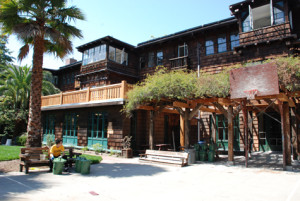Continue reading Thriving Communities Weekly Round Up – 6/27/18
Category Archives: cohousing
The co-op alternative
Before Burlingtonians succumb to the blandishments of “purpose-built” student-housing developers, they might do well to consider an alternative with a long tradition of affordability: student co-op housing.
Student housing co-ops are scattered around the country. Perhaps the best known is the Berkeley Student Cooperative, which dates from 1933 and offers housing to about 1,300 students in 20 properties.  According to the co-op’s website, monthly rent is about $745 in a room and board house (compared to $1,354 in a university dorm triple) and $433 to $881 a month for single room in an apartment. (By comparison, the market rate for a one-bedroom apartment is typically over $2,000.) No wonder there are 1,000 students on the waiting list.
According to the co-op’s website, monthly rent is about $745 in a room and board house (compared to $1,354 in a university dorm triple) and $433 to $881 a month for single room in an apartment. (By comparison, the market rate for a one-bedroom apartment is typically over $2,000.) No wonder there are 1,000 students on the waiting list.
And yes, some of those Berkeley co-op houses have game rooms and hot tubs.
A thumbnail case for student co-ops can be found here, on the website of the North American Students of Cooperation (NASCO). Housing co-ops operate on variations of a shared-equity model. Here’s NASCO’s description of a common form:
“In a ‘Market Equity’ coop, a member joins the coop, buys a share, and lives in a unit. This is similar to something like a condo complex, but instead of owning one condo, you own a share in the whole complex. When you decide to leave the coop, you can sell your share at whatever the market will pay for it.”
Housing co-ops also come with shared governance, work expectations, and so on. They’re not limited to students, of course. Champlain Housing Trust has five co-ops with 81 apartment units in Burlington, with another one on the way on Bright Street.
You’ll never be faced with this choice, but it never hurts to ask: Which would you rather see on the northeast corner of North Winooski Avenue and Main Street: purpose-built student housing, with a climbing wall, or a student housing co-op without one?
More brainstorming: self-building
The housing-unaffordability problem is too big, pervasive and complex to yield to single, simple remedies. Yes, government at all levels has to play a substantially bigger role than it does now. But without substantial new federal funding and subsidies — which can’t be found on mainstream politicians’ lists of spending priorities — we might as well brainstorm about piecemeal, alternative solutions.
Having touched on co-living and cohousing in the last post, we bring you a continental variant of this idea: collective building.
This intriguing headline in the Guardian, “The do-it-yourself answer to Britain’s housing crisis,” offers an entrée: community members, with help from a land trust, building their own affordable homes. Britain even has an organization, the National Custom and Self-Build Association, to promote such efforts.
Self-building seems to be an even bigger trend on the continent. In Germany, baugruppen, or building groups, are active all over, and reportedly account for 10 percent of new homes built in Berlin.  These are groups of people who come together, often with something in common (they might be musicians, say, or share a political philosophy), and take responsibility for acquiring land, hiring architects and contractors, and creating their own housing. For a summary of how it works, click here, or another brief description, here.
These are groups of people who come together, often with something in common (they might be musicians, say, or share a political philosophy), and take responsibility for acquiring land, hiring architects and contractors, and creating their own housing. For a summary of how it works, click here, or another brief description, here.
The baugruppe is a well-established form of organization in Germany and apparently gets a good deal of institutional support, including financing from a state bank. Whether something like this could work in this country is an open question.
Mike Eliason, a designer who was author of a seven-part series on baugruppen, seems to think it could, at least in a place like Seattle. For the first article, on the website of a Seattle advocacy organization called The Urbanist, click here. As Eliason describes it, baugruppen projects cost less than traditional models because they do without developers and marketing, as well as real estate agents.
It all sounds reminiscent of cohousing, except that it’s commonly done in an urban setting — as the photos in this post reflect. It also sounds like a fairly middle-class phenomenon, considering how much of a personal investment it requires of its participants. Who has the time and energy necessary to do all the meeting and planning and hiring and so on? Probably not someone who holds down two minimum-wage jobs. Not that we don’t need affordable housing, sometimes called workforce housing, for middle-class professional types, too.
Scaling back, sort of
A new verb, or gerund, is twittering its way into the contemporary housing lexicon: “co-living.”
It’s often paired with “co-working,” another neologism, and “micro-housing.” These words are being used most commonly to describe the emerging lifestyles of highly driven, hard-striving young entrepreneurs, typically in technical fields — Millennial start-up wannabes, they’re sometimes called in the literature. Harnessed to their ambitions, they’re willing to live in tiny spaces with some common amenities (co-live), work in open-space offices where they can freely network and brainstorm with peers (co-work), and abandon the idea of maintaining a conventional “work-life balance.”
Harnessed to their ambitions, they’re willing to live in tiny spaces with some common amenities (co-live), work in open-space offices where they can freely network and brainstorm with peers (co-work), and abandon the idea of maintaining a conventional “work-life balance.”
These patterns reportedly originated in the Bay Area, as you might expect, but are showing up in New York. This summer, the Times ran a story about Pure House, one of several businesses renting apartments with amenities to such people who are willing to pay $1,600 to $4,000 a month to share rooms with others of their ilk. “The Millennial Commune,” read the headline. (For BuzzFeed’s elaboration on this phenomenon, click here.)
We’ve never met anybody like that, but we take it on faith that such people really do exist. What we’d like to suggest, though, is that some variant of co-living might have appeal for ordinary people, too – Millennials and oldsters, alike. We’ll explain in a moment, but first, let’s be clear that co-living is not the same as cohousing.
Cohousing, as the Cohousing Association of the United States describes it, is “an intentional community of private homes clustered around shared space.” There are many variations of this basic idea of combining private and communal space, and a couple of dozen of these communities have sprung up around Vermont. These are clustered developments, but they’re not necessarily adduced as an answer to the housing-unaffordability problem because of the added costs associated with the shared facilities.
Co-living, by contrast, puts people in tiny apartments (say, 200-300 square feet) with access to some shared space (such as a communal kitchen and lounge). Typically, these are furnished rentals.
An example is Commonspace, 21 micro units being developed on two floors of a five story building in Syracuse, N.Y., above a co-working office space. Each unit will have a bathroom and a kitchenette and will rent from $700 to $900 a month — supposedly slightly less than a one-bedroom apartment goes for in Syracuse, according to a fine profile in The Atlantic. 
Quite apart from the “co-working” annex, micro-units have proliferated in Seattle over the last few years and appear to appeal especially to people who want to live close by where they work.
Now obviously, this sort of place is not for everyone. It means, among other things, giving up the idea that you’ll be paying for living quarters big enough to hold all your seldom-used stuff.
But it might make sense for lots of people — recent college grads working their first jobs, dislocated workers or homeless people getting back on their feet, retirees living on fixed incomes. Not that all these people would necessarily have live together, but assorted communities might suggest themselves.
And beyond rentals, perhaps different ownership models could be devised by land trusts, using judicious public subsidies, all with an eye to affordability.